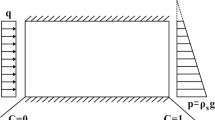Abstract
The intrusion of sea saltwater has destructive effects on freshwater resources as well as hydraulic structures. The first disastrous effect is reducing the volume of available freshwater storage and reducing available surface water quality. Various methods are used to prevent salinity intrusion into upstream river. One of the applied systems in reducing salinity intrusion in the mouth of rivers and especially in the shipping locks is the air bubbles curtain. For proper use of the air bubbles curtain system, it is necessary to determine the effect of different parameters on its performance. Therefore, in the present study, the effect of seawater density and air bubbles discharge on the performance of the air bubbles curtain was studied using a numerical model. The results show that the air bubbles curtain can prevent salinity intrusion by forming a vertical flow. Indeed, the air bubbles curtain's proper performance depends on the air bubbles discharge and the difference between saltwater and freshwater density. In other words, an increase in the density of seawater raises the salinity intrusion force and thus leads to the formation of a clockwise rotational flow upstream of the air bubbles curtain, which in turn intensifies the salinity intrusion into upstream of the air bubbles curtain and reduces the efficiency of the air bubbles curtain. Increasing air bubbles discharge culminates in preventing saltwater intrusion, although there is an optimal discharge that discharges greater than it has insignificant effects on air bubbles curtain performance.











Similar content being viewed by others
References
Abraham G, Burgh P (1964) Pneumatic reduction of salt intrusion through locks. J Hydraul Division ASCE 90(1):83–119
Abraham G, Burgh P, De Vos P (1973) Pneumatic barriers to reduce salt intrusion through locks, No. 17, Government Publishing Office: The Hague, Netherlands. http://resolver.tudelft.nl/uuid:e3e1ba53-8f09-43c1-8247-7c032b8604c2
Asaeda T, Arita M, Son PH (1997) Prevention of saline wedge intrusion by an air curtain in an estuary, Doboku Gakkai Ronbunshu. Japan Soc Civil Eng 1997(572):23–31. https://doi.org/10.2208/jscej.1997.572_23
Dugué V, Blancckaert K, Chen Q, Schleiss AJ (2015) Influencing flow patterns and bed morphology in open channels and rivers by means of an air-bubble screen. J Hydraul Eng 141(2):1–13. https://doi.org/10.1061/(ASCE)HY.1943-7900.0000946
Fluent Theory Guide 18.2.0 (2018) Fluent Inc.
ITTC (2011) Recommended Procedures: Fresh Water and Seawater Properties—7.5–02–02–01.02, ITTC Quality Systems Group of the 28th ITTC, pp. 1–45.
Johnson T, (2007) Battling seawater intrusion in the central and west coast basins, WRD Technical Bulletin, 13.
Keetels G, Uittenbogaard R, Cornelisse J, Villars N, Pagee HV (2011) Field study and supporting analysis of air curtains and other measures to reduce salinity transport through shipping locks, Irrigation and Drainage. Wiley Online Library 60:42–50. https://doi.org/10.1002/ird.679
Mohammed R, Scholz M (2017) Critical review of salinity intrusion in rivers and estuaries. J Water Climate Change 9(1):1–16. https://doi.org/10.2166/wcc.2017.334
Nabhani N (2011) Fluid Mechanics, In Sharif University of Technology Applications, Iran (In Persian).
Nakai M, Arita M (2002) An experimental study on prevention of saline wedge intrusion by an air curtain in rivers. J Hydraul Res 40(3):333–339
Oldeman AM, Kamath S, Masterov MV, O’Mahoney TSD, van Heijst GJF, Kuipers JAM, Buist KA (2020) Numerical study of bubble screens for mitigating salt intrusion in sea locks. Int J Multiph Flow. https://doi.org/10.1016/j.ijmultiphaseflow.2020.103321
Sasaki T, Asaeda T (1993) Air curtain for preventing the salt water intrusion in estuaries. Env Syst Res Japan Soc Civil Eng 21:335–339. https://doi.org/10.2208/proer1988.21.335
Uittenbogaard R, Cornelisse J, O’Hara K (2015) Water—Air bubble screens reducing salt intrusion through shipping locks, 36th IAHR World Congress, 28 June-3 July 2015. The Netherlands, The Hague
Van der Ven PPD, Oldenziel G (2018) A scale model study assessing the performance of a bubble screen mitigating salinity driven lock exchange. In: Proceedings of the 5th IAHR Europe Congress — New Challenges in Hydraulic Research and Engineering, pp. 673–674. https://doi.org/10.3850/978-981-11-2731-1.
Van der Ven PPD, Wieleman V (2017) The use of small scale experiments for a shipping lock’s bubble screen.In: 4th International symposium of shallow flows, 2(June), pp. 26–28. https://doi.org/10.1016/j.cub.2015.10.018.
Van der Ven PPD, O’Mahoney TSD, Weiler OM (2018) Methods to assess bubble screens applied to mitigate salt intrusion through locks. PIANC-World Congress Panama City, pp. 1–17.
Acknowledgements
This research did not receive any specific grant from funding agencies in the public, commercial, or not-for-profit sectors
Author information
Authors and Affiliations
Corresponding author
Ethics declarations
Conflict of interest
The authors declare that they have no known competing financial interests or personal relationships that could have appeared to influence the work reported in this paper.
Ethical approval
This article does not contain any studies with human participants or animals performed by any of the authors.
Additional information
Editorial responsibility: M. Abbaspour.
Supplementary Information
Below is the link to the electronic supplementary material.
Rights and permissions
About this article
Cite this article
Talebi, A., Salehi Neyshabouri, S.A.A. & Khoshgou, H. Investigation on factors affecting the performance of the air bubble curtain in preventing the penetration of salinity. Int. J. Environ. Sci. Technol. 19, 10599–10612 (2022). https://doi.org/10.1007/s13762-022-04232-6
Received:
Revised:
Accepted:
Published:
Issue Date:
DOI: https://doi.org/10.1007/s13762-022-04232-6




